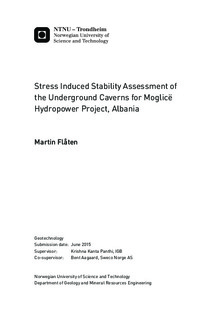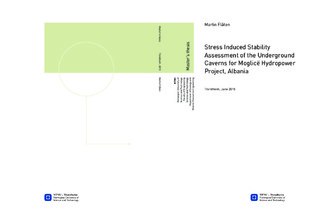| dc.description.abstract | As a heavy investment to the Albanian renewable energy production, Devoll hydropower project (DHPP) is under development. DHPP is located in the southeast of Albania and consists of three hydropower plants, where Moglicë is the largest with its 175 MW. The powerhouse and transformer hall of the Moglicë plant will be placed underground. This thesis targets to optimize the location, orientation and spacing between the caverns in the Moglicë plant. To achieve this optimization, engineering geological conditions including rock mass properties and stress situation in the Moglicë area have been evaluated.
The original placement and orientation of the caverns from the background information are assessed. In addition, an alternative placement and orientation is proposed to reduce the length of the appurtenant tunnel system and minimize the impact of stress induced instabilities. These two alternatives are compared throughout the thesis.
An in-depth stability assessment of the underground caverns is carried out, with the scope of evaluating possible stress induced instabilities for the caverns. This analysis includes analytical, empirical and numerical methods. The analysis detected brittle failure in the cavern roofs and tensile fracturing in the cavern walls due to magnitude and anisotropy in the redistributed stresses. Stress induced instabilities will be more extensive in the powerhouse cavern relative to the transformer hall due to its shape and size.
Analytical and empirical studies includes Kirsch s equations and an approach from Hoek & Brown (1980) to assess the redistribution and concentration of stresses in the cavern contour. Spalling potential and depth of brittle failure are estimated based on cavern span, rock mass spalling strength and tangential stresses. These results are compared to estimations of failure depth from numerical analysis using the deviatoric stress criterion and analysis of strength factor with Hoek-Brown brittle parameters in the 2D finite element program, Phase2. A reasonable coherence between the methods are found considering the associated uncertainties.
Support measures are proposed based on empirical relations between cavern span and bolt lengths, recommendations from the Q-system and analysis of yielding and deformation from the numerical results.
From the assessment of engineering geological conditions and the in-depth stability analysis, a pillar width of 22 m is suggested for the original placement and orientation, and 26 m pillar for the alternative placement and orientation. It is considered feasible to obtain a satisfactory level of stability for both locations and orientations, considering the rock mass properties and stress condition that are most likely to occur. However, the worst case numerical analysis showed significant stability problems. Placing large scale underground caverns in such conditions is not advisable. | |

